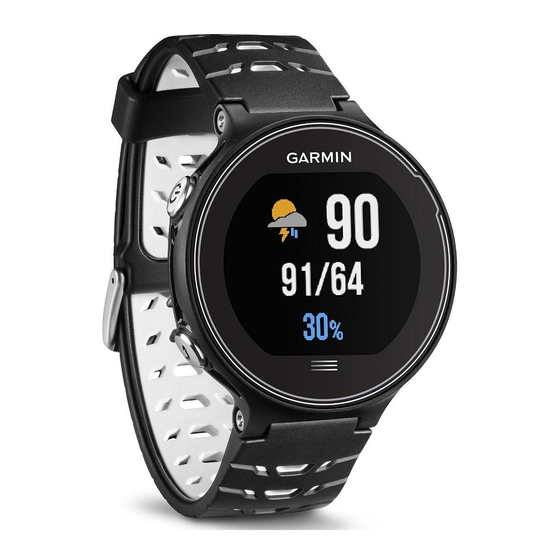Garmin Forerunner 630 Gebruikershandleiding - Pagina 14
Blader online of download pdf Gebruikershandleiding voor {categorie_naam} Garmin Forerunner 630. Garmin Forerunner 630 24 pagina's.

lactate threshold can help you determine how hard to train or
when to push yourself during a race.
If you already know your lactate threshold heart rate value, you
can enter it in your user profile settings
Zones, page
8).
Performing a Guided Test to Determine Your Lactate
Threshold
Before you can perform the guided test, you must put on a heart
rate monitor and pair it with your device
page
7). You must also have a VO2 max. estimate from a
previous run
(About VO2 Max. Estimates, page
TIP: The device requires a few runs with a heart rate monitor to
get an accurate maximum heart rate value and VO2 max.
estimate.
1
Select an outdoor running profile.
GPS is required to complete the test.
2
Select
> My Stats > Lactate Threshold > Do Guided
Test.
3
Follow the on-screen instructions.
Viewing Your Performance Condition
Before you can view your performance condition, you must put
on a heart rate monitor and pair it with your device
ANT+ Sensors, page
7).
As you run, the performance condition feature analyzes your
pace, heart rate, and heart rate variability to make a real-time
assessment of your ability to perform compared to your average
fitness level. During the first 6 to 20 minutes of your run, the
watch displays your performance condition score. For example,
a score of +5 means that you are rested, fresh, and capable of a
good run. You can add performance condition as a data field to
one of your training screens to monitor your ability throughout
the run. Performance condition can also be an indicator of
fatigue level, especially at the end of a long training run.
NOTE: The device requires a few runs with a heart rate monitor
to get an accurate VO2 max. estimate and learn about your
running ability
(About VO2 Max. Estimates, page
1
Add Performance Condition to a data screen
the Data Screens, page
2
Go for a run.
After 6 to 20 minutes, your performance condition appears.
3
Scroll to the data screen to view your performance condition
throughout the run.
10
(Setting Your Heart Rate
(Pairing ANT+ Sensors,
9).
(Pairing
9).
(Customizing
11).
Viewing Your Stress Score
Before you can view your stress score, you must put on a heart
rate monitor and pair it with your device
page
7).
Stress score is the result of a three-minute test performed while
standing still, where the Forerunner device analyzes heart rate
variability to determine your overall stress. Training, sleep,
nutrition, and general life stress all impact how a runner
performs. The stress score range is 1 to 100, where 1 is a very
low stress state, and 100 is a very high stress state. Knowing
your stress score can help you decide if your body is ready for a
tough training run or yoga.
TIP: Garmin recommends that you measure your stress score at
approximately the same time and under the same conditions
every day.
1
Select Apps > Stress Score > Measure.
2
Stand still, and rest for 3 minutes.
Foot Pod
Your device is compatible with the foot pod. You can use the
foot pod to record pace and distance instead of using GPS when
you are training indoors or when your GPS signal is weak. The
foot pod is on standby and ready to send data (like the heart
rate monitor).
After 30 minutes of inactivity, the foot pod powers off to
conserve the battery. When the battery is low, a message
appears on your device. Approximately five hours of battery life
remain.
Going for a Run Using a Foot Pod
Before you go for a run, you must pair the foot pod with your
Forerunner device
(Pairing ANT+ Sensors, page
You can run indoors using a foot pod to record pace, distance,
and cadence. You can also run outdoors using a foot pod to
record cadence data with your GPS pace and distance.
1
Install your foot pod according to the accessory instructions.
2
Select the Run Indoor activity profile.
3
Go for a run.
Foot Pod Calibration
The foot pod is self-calibrating. The accuracy of the speed and
distance data improves after a few outdoor runs using GPS.
Customizing Your Device
Setting Up Your User Profile
You can update your gender, birth year, height, weight, and
heart rate zone settings. The device uses this information to
calculate accurate training data.
1
Select
> My Stats > User Profile.
2
Select an option.
Activity Profiles
Activity profiles are a collection of settings that optimize your
device based on how you are using it. For example, the settings
(Pairing ANT+ Sensors,
7).
Customizing Your Device
